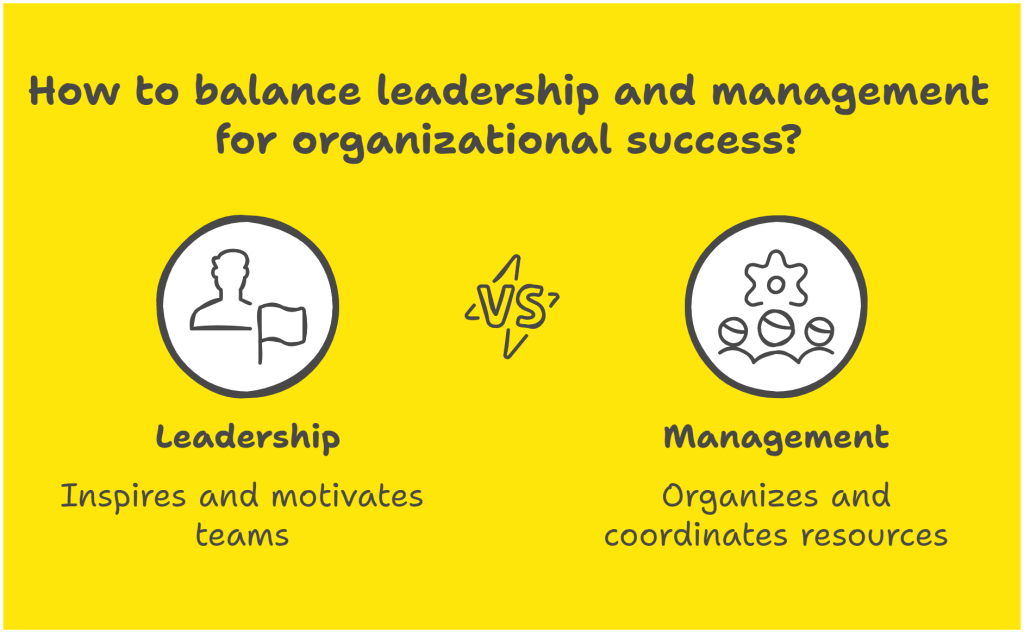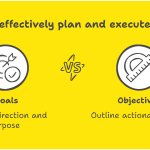In the fast world of business, knowing the difference between leadership and management is key. My experience in corporate settings showed that these terms are not the same. They are different ways to lead and manage teams for success.
The world of leadership vs management is complex. Leaders inspire and set new paths. Managers carry out plans and keep things running smoothly. This mix is what makes a company innovative and strong.
Companies that get this difference do better. They create strong, changing work places. They see leadership and management as important together, not against each other. This teamwork leads to growth and happy employees.
Key Takeaways
- Leadership and management are distinct but complementary skills
- Leaders focus on vision and inspiration
- Managers concentrate on execution and operational efficiency
- Successful organizations integrate both approaches
- Understanding these differences enhances organizational performance
Understanding the Core Concepts of Leadership and Management
Leadership and management are key to success in organizations. They are not the same, but both are important. Leadership guides people and sets goals. Management focuses on how things get done.
Today, leaders and managers are vital for a productive team. Knowing the difference helps companies grow. They can make better plans for how to work together.
Also Read: The Key Differences Between Goals and Objectives
Defining Leadership in Modern Organizations
Leadership is more than just being in charge. It’s about inspiring and empowering people. It includes:
- Creating a clear vision
- Encouraging new ideas
- Building good relationships
- Changing the culture

The Fundamental Nature of Management
Management is about getting things done efficiently. It involves planning, checking progress, and keeping things steady. Managers use:
- Planning and organizing
- Tracking results
- Keeping things consistent
- Keeping the organization stable
Also Learn: AI vs Machine Learning: Key Differences Explained
Historical Evolution of Both Disciplines
| Era | Leadership Focus | Management Approach |
|---|---|---|
| Early 20th Century | Hierarchical command structures | Scientific management principles |
| Mid-20th Century | Collaborative team dynamics | Process standardization |
| Modern Era | Adaptive and transformational strategies | Agile and flexible management techniques |
Leadership and management keep changing with business. They need to be flexible and strategic.
Difference Between Leadership and Management

Leadership and management are two key parts of making a business succeed. They work together but have different main jobs and views.
Leaders inspire and motivate teams. They create a vision and push for change. Their main strengths are:
- Setting strategic direction
- Inspiring team members
- Encouraging innovation
- Developing long-term perspectives
Managers focus on carrying out plans and keeping things running smoothly. Their main tasks are:
- Implementing detailed plans
- Organizing resources
- Monitoring performance
- Ensuring consistent productivity
Leaders and managers work together well. Leaders set the vision, and managers make it happen. Good companies know both roles are needed for growth.
Being a good leader means more than just managing. It needs emotional smarts, being flexible, and the power to get teams to work together. Managers, on the other hand, need to be precise, organized, and consistent.
Key Characteristics of Effective Leaders
Leadership is a complex art that needs a mix of skills and qualities. Great leaders inspire and drive success. Knowing these skills can make ordinary managers into great leaders.

The best leaders have a special mix of qualities. These qualities help them make a real difference, not just manage.
Vision and Strategic Thinking
Good leaders start with a clear vision. They can:
- See what’s coming in the market
- Make plans for the future
- Share complex ideas clearly
- Get teams excited about big goals
Emotional Intelligence and People Skills
Emotional intelligence is key. It helps leaders:
- Get team dynamics
- Manage relationships
- Deal with tough workplace situations
- Build trust and safety
Adaptability and Innovation
Today’s leaders need to be adaptable. They show:
- They can handle tough situations
- They’re open to new ideas
- They make quick, smart decisions
- They welcome change
| Leadership Quality | Key Characteristics | Impact |
|---|---|---|
| Strategic Vision | Forward-thinking perspective | Drives organizational growth |
| Emotional Intelligence | Empathy and relationship management | Enhances team performance |
| Adaptability | Flexibility and continuous learning | Ensures organizational resilience |
Leadership qualities are not born but grown. Great leaders keep learning and growing. They see leadership as a journey of constant improvement.
Essential Management Skills and Competencies
Good management is more than just doing paperwork. It needs a mix of skills to help businesses succeed today. Managers must have a wide range of abilities to handle tough work problems.
- Strategic Planning
- Resource Allocation
- Performance Monitoring
- Team Development
Managers need many skills to do well. Knowing how to use technology is important. But, being good with people is even more key in today’s business world.
| Skill Category | Core Competencies | Impact Level |
|---|---|---|
| Technical Skills | Data Analysis, Process Optimization | High |
| Leadership Skills | Communication, Motivation, Conflict Resolution | Critical |
| Strategic Skills | Decision Making, Long-term Planning | Essential |
To get better at management, you must keep learning and thinking on your feet. Good managers know their job is always changing. They must keep growing to tackle new challenges.
Leadership Styles vs. Management Approaches
Understanding leadership and management is complex. Today’s businesses see that good leadership is more than just following rules. They look for new ways to lead.
Now, companies are trying out new leadership methods. They mix different ways to get the best from their teams and keep everyone happy.
Transformational Leadership
Transformational leadership aims to inspire and push team members to do their best. It’s about:
- Creating a clear vision
- Helping people grow personally and professionally
- Encouraging new ideas and creativity
- Building strong bonds with team members
Traditional Management Methods
Traditional management focuses on order, control, and knowing what to expect. It’s about:
- Decisions made by those at the top
- Clear goals and how to measure success
- Following set rules and steps
- Telling everyone what to do
Hybrid Approaches in Modern Business
Today, leaders mix different styles to get the best results. They use a mix that:
- Combines big plans with day-to-day work
- Allows for change and being flexible
- Keeps things organized but also lets people be creative
- Supports learning and growing all the time
Being a good leader today means knowing many management styles. Leaders create cultures that are dynamic, responsive, and high-performing.
Building High-Performing Teams: Leadership and Management Perspectives
Creating high-performing teams is a balance between leadership and management. Leaders inspire and motivate. Managers set up structures that help the team succeed.
When building team dynamics, leadership vs management is clear. Leaders focus on vision and emotional connection. Managers work on operational efficiency and achieving goals.
- Leadership drives team motivation and innovation
- Management ensures systematic process implementation
- Collaborative approaches maximize team’s full power
The mix of leadership and management is key for team growth. Successful groups see these roles as working together, not against each other.
| Leadership Focus | Management Focus |
|---|---|
| Inspirational vision | Operational planning |
| Emotional intelligence | Performance metrics |
| Cultural transformation | Process optimization |
By blending leadership with strong management, teams can reach their best. This leads to great performance and lasting growth.
Conclusion
The difference between leadership and management is key to success in today’s world. Effective leaders inspire teams and make workplaces better. They go beyond just managing things well.
Leadership is about innovation and vision, while management is about being efficient. When leaders and managers work together, they make great teams. They use their skills to make the workplace better.
Knowing how leadership and management work together is very important. People who know both well can handle tough jobs. They keep learning and growing, leading to lasting success.
The best companies see leadership and management as part of the same thing. They focus on both vision and doing things well. This way, they reach their full strength and make great workplaces.
FAQ
What is the primary difference between leadership and management?
Leadership is about inspiring and guiding. It’s about creating a vision. Management is about organizing and planning. It’s about making sure things get done.
Can someone be both a leader and a manager?
Yes, many people are both. They inspire teams and manage resources. This mix is key to success in many roles.
How do leadership styles impact organizational performance?
Leadership styles affect motivation and productivity. Some leaders drive innovation. Others focus on getting things done right.
What are the key qualities of an effective leader?
Good leaders are smart and adaptable. They communicate well and are honest. They inspire teams to work together.
Do management techniques differ across industries?
Yes, they do. Each industry has its own needs. Technology and healthcare need special approaches.
How important is continuous leadership development?
It’s very important. Leaders need to keep learning. This helps them stay ahead in a changing world.
What role does emotional intelligence play in leadership?
Emotional intelligence is key. It helps leaders understand people. They can build strong relationships and solve problems.
How do management and leadership contribute to team performance?
Management gives structure and resources. Leadership inspires and guides. Together, they help teams do their best.
What are the most effective leadership development strategies?
Good strategies include mentorship and training. Also, learning by doing and getting feedback are important. Self-reflection helps too.
How do leadership approaches differ globally?
They vary a lot. Different cultures have different values and ways of communicating. Understanding these differences is key to being a good global leader.



